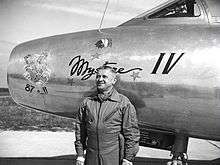Constantin Rozanoff
| Constantin Wladimir Rozanoff | |
|---|---|
 Kostia Rozanoff near Mystère IV | |
| Nickname(s) | Kostia |
| Born |
23 August 1905 Warsaw, Russian Empire |
| Died |
3 April 1954 Melun, France |
| Allegiance |
|
| Years of service | 1940–1946 |
| Rank | Colonel |
| Unit | GC II/4, GC 2/5 «Lafayette», GC 2/3 «Dauphiné» |
| Battles/wars | World War II |
| Awards | Air Medal, Légion d'honneur |
Constantin Wladimir Rozanoff, also known as Kostia Rozanoff, (Russian: Розанов, Константин Владимирович) (August 23, 1905 – April 3, 1954) - was a French test pilot, Colonel of the French Air Force, and one of the pioneers of jet aviation. He was chief-pilot at Dassault Aviation.[1] He flew 201 types of planes and helicopters, and accumulated 5,000 flying hours, including 3,865 combat hours, and breaking the sound barrier 104 times.
Early life
Constantin Rozanoff was born to a Russian family in Warsaw. He and his mother emigrated to France in 1917 because of the Revolution, and in 1927 obtained French citizenship. Constantin Rozanoff entered the prestigious engineering school École Centrale Paris, where he graduated in 1928. Called into military service the same year, he completed his service with the 34th Aviation Regiment of observation at Le Bourget and as a reserve officer at Avord.
He attended the SUPAERO National Aircraft School (L'École nationale supérieure de l'aéronautique et de l'espace) in 1933, and after completing studies he became a licensed pilot. In 1935 he became a pilot with the Center of Aeronautics in Vélizy-Villacoublay (Centre d'Essais des Matériels Aéronautiques - CEMA) and took part in flight testing of the Morane-Saulnier MS.406, Dewoitine D.520 and Bloch MB.152. In October 1937, Rozanoff was almost killed when losing control of a Hanriot while testing its spin characteristics. He could not recover in time, but he bailed out safely.
War Service
In February 1940 Rozanoff became second in command of Groupe de chasse GC II/4 and flew operations in the Battle of France. In May 1940 he shot down two Luftwaffe fighter planes in a Curtiss P-36.
After occupation in 1942 he travelled to (Morocco) where he participated operations with the Allies in Tunis and Algeria, and on convoy operations over the Mediterranean flying the Curtiss P-40 (with onboard sign «MadKot»). He commanded GC 2/5 («Lafayette») and GC 2/3 («Dauphiné»).[2]
In December 1943 he went to Great Britain where, promoted to lieutenant colonel, attended additional test pilot courses, including one at the Central Flying School. He flew the first RAF jet, the (Gloster G-41), then participated in flight testing the P-59 Airacomet and Lockheed P-80 Shooting Star in the USA.
Postwar
In December 1945 after returning from the USA as a Colonel he served at Airbase 118 in Mont-de-Marsan, later named after him.[3]
He was demobilised in October 1946 and headed the Test Division of the Dassault Aviation (as chief-pilot). Colonel Rozanoff became the chief test pilot flying the MD-450 Ouragan and participated in testing military transport planes such as the Dassault MD.315 Flamant, and the fighter-bomber Mystère (I-IV).
Rozanoff became the first Frenchman to break the sound barrier in level flight, on 24 February 1954, with the Mystère IV B.[4][5][6][7]
In 1954 Constantin Rozanoff published his autobiographical- Double Bang - Ma Vie de Pilote d'Essai.
Colonel Rozanoff was killed in a crash of a Mystère IV B during a public low-level flight over the Melun Villaroche Aerodrome.[8][9]

He was buried in the Passy Cemetery.[10]
He was awarded the Air Medal and the cross of the Légion d'honneur.
References
- ↑ Munson, Kenneth. (1967) Aircraft Profile 143: Dassault MD.450 Ouragan. Berkshire: Profile Publications.
- ↑ Marquettes au 1972eme - Curtiss P-40 au Lafayette
- ↑ Air BA 118 Mont de Marsan - Armée de l'air
- ↑ Dassault MD.450 Ouragan - Conservatoire de l'Air et de l'Espace d'Aquitaine - CAEA
- ↑ Mystère II - Conservatoire de l'Air et de l'Espace d'Aquitaine - CAEA
- ↑ Mystère IV A - Conservatoire de l'Air et de l'Espace d'Aquitaine - CAEA
- ↑ FLIGHT, 14 November 1952 - Mystere IV's 683 mph
- ↑ FLIGHT, 9 April 1954 - Colonel Rozanoff
- ↑ Kostia Rozanoff (lieu du crash) - Aérosteles: Lieux de mémoire aéronautique
- ↑ Tombe Kostia Rozanoff - Aérosteles: Lieux de mémoire aéronautique
External links
- Groupe de Chasse II/4
- Historique de la Base aérienne 118 de Mont de Marsan
- Constantin Rozanoff, «Kostia», pilote de chasse - Aerostories
- Rozanoff Constantin, «Kostia» - Ciel De Gloire
- "Constantin "Kostia" Rozanoff". Dassault Aviation. Retrieved 16 June 2009.
- "Slideshow. The Paris Air Show: A Look Back". New York Times. 14 June 2009. Retrieved 16 June 2009.